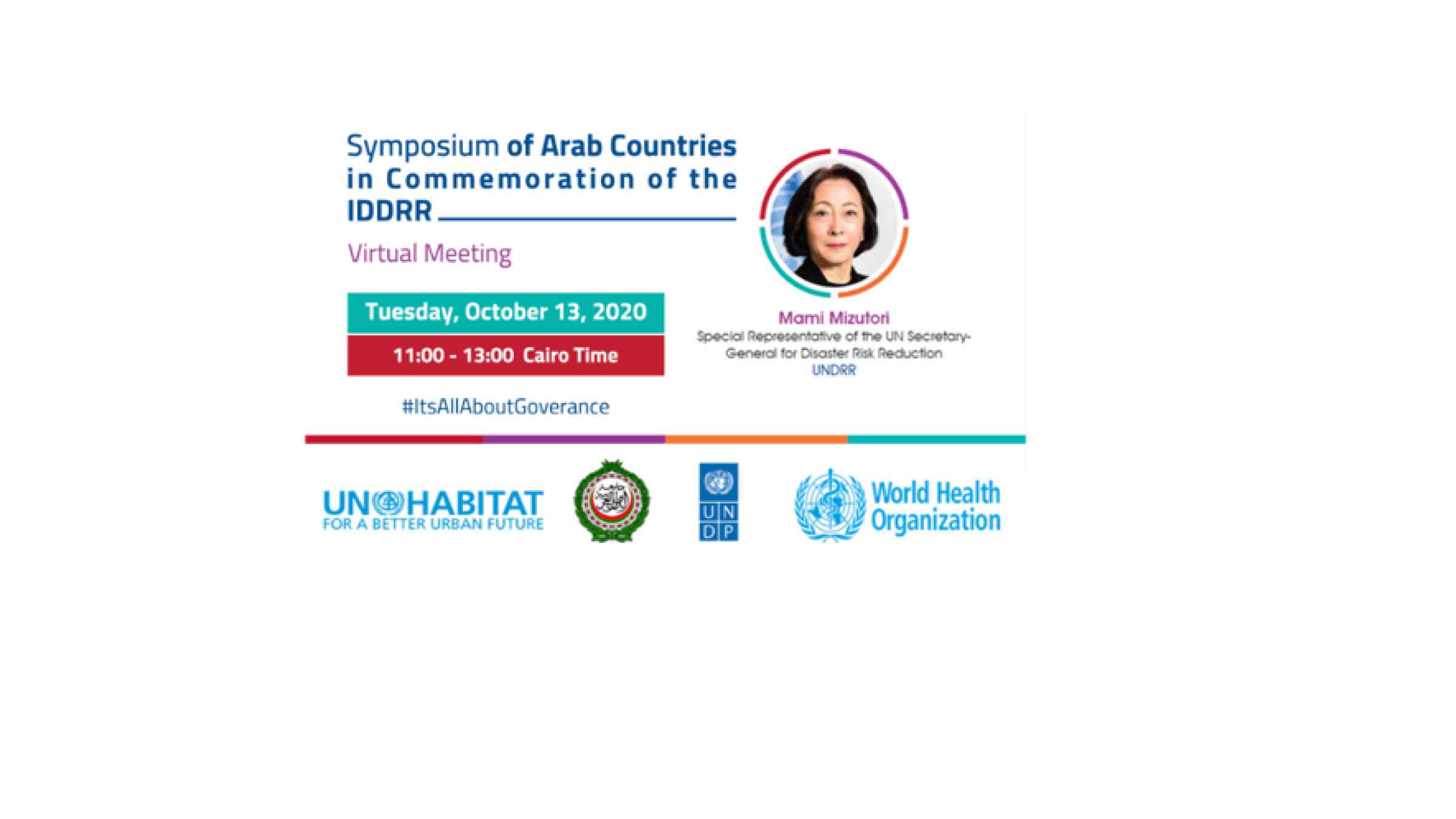Symposium of Arab Countries in Commemoration of the IDDRR

https://undrr.zoom.us/webinar/register/WN_jYzvCQ75Qzu-Ea2WyH4G7Q
Objective:
The main objective of the webinar is to highlight how good disaster risk governance, planning and implementation leads to reduced numbers of people affected by disasters (especially in terms of death, injury, displacement and loss of livelihood).
The webinar will focus on Target E, disaster risk governance and the need to develop policy, legislative frameworks, and institutional architecture and associated investment vehicles for disaster risk reduction in line with the goal, targets and priorities for action of the Sendai Framework.
Highlight the challenges, demonstrate a deep understanding of disaster risk, and allow for a more complete engagement of communities to take an active part in contributing to the development and implementation of national and local strategies for disaster risk reduction.
Address the full scope of the Sendai Framework in the strategies for DRR which applies to disasters caused by natural or man-made hazards, as well as related environmental, technological and biological hazards and risks.
Identify clear actions that we can take in the Arab countries, communities, individuals, and organizations to improve how we manage disaster risk in order to reduce it and how to avoid creating new risk by systematically reduce existing risk. Also, reflect on how we can strengthen the capacity of people, communities, countries and systems to anticipate, withstand and recover better from shocks and stresses and transform through crises.
Background:
The United Nations General Assembly has designated 13 October as International Day for Disaster Risk Reduction to promote a global culture of disaster risk reduction. It is an opportunity to acknowledge the progress being made toward reducing disaster risk and losses in lives, livelihoods and health in line with the Sendai Framework for Disaster Risk Reduction 2015-2030 adopted at the Third UN World Conference on Disaster Risk Reduction in Japan in March 2015.
The Sendai Framework has seven strategic targets and 38 indicators for measuring progress on reducing disaster risk and losses. These indicators align implementation of the Sendai Framework with implementation of the SDGs and the Paris Agreement on climate change.
The 2020 target is Target E: “Substantially increase the number of countries with national and local disaster risk reduction strategies by 2020” which lays the foundation for the implementation of the Sendai Framework and is closely linked with Priority for Action 2: “Strengthening disaster risk governance to manage disaster risk.”
Good national and local strategies for disaster risk reduction include links with sector policies in areas such as land use, building codes, public health, education, agriculture, environmental protection, energy, water resources, poverty reduction and climate change adaptation.
The issues of disaster risk governance – identifying and acknowledging, planning and acting on disaster risk – have come into sharp focus this year, as evidence accumulates of the failure of many countries to heed the many warnings in recent years, and prepare for global threats such as a major pandemic like COVID-19.
Key Questions to be Addressed by Partners:
- How national and local disaster risk reduction strategies strengthened institutional mechanisms and are instrumental in preventing creation of new risk, the reduction of existing risk and the improving of economic, social, health and environmental resilience?
- How empowerment of local authorities can be more effective through regulatory and financial means to work and coordinate with civil society, communities including migrants in disaster risk management at the local level?
- How UN and international organisations foster collaboration across global and regional mechanisms and institutions for the implementation and coherence of instruments and tools relevant to disaster risk reduction?
- How intergovernmental organisations such as LAS and UN together can further promote transboundary cooperation to enable policy and planning for the implementation of ecosystem-based approaches with regard to shared resources, to build resilience and reduce disaster risk, including epidemic and displacement risk?
Key Questions to be Addressed by National Focal Points:
- Does your national strategy for disaster risk reduction have a clear vision supported by plans, the necessary competence, legislation, resources, guidance and coordination within and across sectors?
- Have you put in place organizational structures to implement the Sendai Framework or risk-informed sustainable development?
- Does your national strategy take a systemic view of risk and seek to strengthen economic, social, health and environmental resilience?
- Do your national and local strategies for disaster risk reduction take adequate account of biological, technological and environmental hazards and risks?
- Have you been able to establish and strengthen government coordination forums composed of relevant stakeholders at the national and local levels, such as national and local platforms for disaster risk reduction, and a designated national focal point for implementing the Sendai Framework for Disaster Risk Reduction 2015–2030?
- Are you addressing disaster risk in publicly owned, managed or regulated services and infrastructures?
- Do you report regularly on your activities and make use of the Sendai Framework Monitor?
Expected outcomes:
- Greater awareness of the importance of governance and political commitment to managing and reducing disaster risk at all levels;
- Greater awareness of the importance of including considerations for disease outbreaks including pandemic risk management in national and local strategies for disaster risk reduction;
- Greater focus on integrating disaster risk reduction and climate change adaptation through prioritization of transboundary and regional cooperation;
- Way forward in strengthening risk governance at all levels. (key recommendations by speakers)
Potential Speakers:
- Mami Mizutori, Special Representative of the Secretary-General for Disaster Risk Reduction and Head of UNDRR
- UN partners (WHO, UNHABITAT, UNDP) and League of Arab States (LAS)
- National and local Sendai focal points intervention and screening live activities celebrating the Day
Duration: 2 hours
Language: English/ Arabic / French
For more information, please contact: Ms. Rania Hammad (rania.hammad@un.org), UNDRR-Regional Office for Arab States.